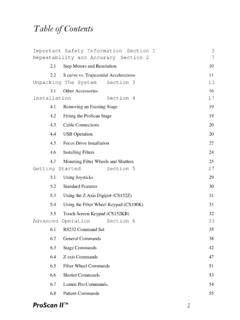Transcription of The ProScan® Survey: Development and Standardization ...
1 The proscan survey : Development and Standardization 1977 -1978 Research was designed to provide a statistically validated, quantitative, instrument. Original pool of 185 adjectives was drawn from works of Thurstone, Cattell, Guilford, Fiske, Daniels, Horst, and the designers of PDP, Hubby, Houston and Solomon. An experimental survey was administered with the responses to the self-descriptive adjectives (positive stimuli) made on a 5-point Likert scale. Factor analysis reduced the final list to 60 self-descriptive adjectives and clearly identified four primary behavioral traits and one secondary trait. Standardization procedures provided separate norms for each trait within each of three perspectives: (1) Basic/Natural Self, (2) Priority Environment(s), and (3) Predictor/Outward Self.
2 The four primary factors of behavior produce a variable norm that permits measurement of the relative intensity of each separate trait in every individual profile. Thus, the distance of each trait from the individual s own central tendency norm provided a measurement of the intensity of that trait. This unique concept and statistical procedure made it possible to measure the strength of individual behavioral traits, not only with reference to other traits of each individual, but also with reference to the population norms. The survey was standardized for the purpose of describing normal behaviors. The major step was the administration of the final list of adjectives to a normative sample.
3 That sample consisted of 1,024 persons who were carefully selected to represent a cross section of adults. Normative data were prepared independently and confirmed by feedback from a large number of case studies. Intrinsic Validity: The instruments of the PDP system were highly replicable with Coefficients of Reliability above .94 for all factors. Each of the factors was highly invariant across race, sex and occupation with coefficients above .87 in all cases. Extrinsic Validity: Coefficients of concurrent validity range from .39 to .87 on selected factor scores of similar instruments. Additional Research of the PDP survey : Validation Study of Criterion-based (predictive) Validity - 1988 This study gave an independent, empirically-based, evaluation of the validity of the PDP proscan ?
4 And PDP JobScan?. This analyses provided support for the use of the PDP proscan ? and PDP JobScan? as predictors of job success. Disparate Impact Study - 1994 The study sample allowed analyses of several protected groups (females and non-white minorities) as defined by current statutory law. The results indicated that the members of either protected group did not score significantly lower on the proscan ? instrument than other individuals. Based on the available evidence, the PDP proscan ? appears to be a fair (non-biased) personnel selection instrument. Independent Review of PDP research Research 1993 In my opinion, PDP has taken appropriate steps to ascertain the validity of their tests.
5 They have consistently used sound experimental procedures to make these determinations and are continuing these activities on an ongoing basis. Excerpt from letter written by Rick M. Gardner, , Professor and Chair, Department of Psychology, University of Colorado at Denver. Monograph No. 9, Validation Study, Disparate Impact Study, and the Technical and Research Reference Guide are furnished to each trained PDP Client organization.









